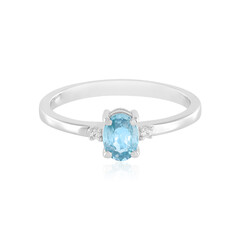Zircon

1. Introduction
This crystal-clear gemstone should not be confused with synthetic cubic zirconia.
2. Name, Origin and History
Name
There are two possible derivations for the name "zircon", which also gave the chemical element "zirconium" its name: on the one hand the Arabic "zarkun" (red) and on the other the Persian words "zar" (gold) and "gun" (colour). This limitation in the colours is misleading, as this gemstone actually occurs in a variety of colours.
Origin
Zircons are found in Cambodia, Nigeria, Sri Lanka and Tanzania, with Cambodia being the main source of blue zircons worldwide.
History
Zircon already existed as a gemstone in ancient times. It has been found in some of the oldest archaeological sites in the world.
It also appears in various ancient writings, including the Bible and a Hindu poem about the mythical Kalpa tree, which is said to have been adorned with zircon leaves. Some sources mention a Jewish legend in which an angel named "Zircon" was said to watch over Adam and Eve in the Garden of Eden. Under its ancient name "Hyacinth", the zircon is mentioned several times in the Bible, first as one of the "fiery stones" (Ezekiel 28:13-16) presented to Moses and placed in Aaron's breastplate (Exodus 28:15-30), and then as one of the twelve precious stones that will adorn the foundation stones of the city wall of the heavenly Jerusalem (Revelation 21:19-20). Andrew, Bishop of Caesarea, was one of the first church writers at the end of the 10th century to associate the twelve precious stones of the Heavenly Jerusalem with the apostles: He assigned the hyacinth (zircon) to the apostle Simon.
3. Characteristics and Formation
Characteristics
Zircons exhibit strong birefringence, where light is split into two rays when it hits the stone. Even to the untrained eye, this effect is immediately recognisable as a doubling of the facets, although this depends somewhat on the viewing angle. Birefringence is more pronounced in thicker gemstones. Although it does not give the stone greater brilliance, it often creates beautiful, sparkling mosaic patterns and gives the impression of greater optical depth. Other characteristics of zircon are its marvellous diamond-like sparkle, its brilliance and its fire.
Formation
Zircon is a natural beauty that consists of zirconium silicate. Zirconia, with which it is often confused, is a product of the laboratory: zirconium dioxide was discovered in 1892, but it was not until 1937 that zirconia was found in its natural state. However, the naturally occurring zirconia crystals are far too small to be cut into gemstones. In the 1970s, Soviet scientists at the Lebedev Institute of Physics in Moscow finally succeeded in growing zirconia crystals in the laboratory. Since the 1980s, zirconia has been marketed as the ultimate substitute for diamonds.
4. Varieties
Zircon comes in countless colours, including blue, champagne, coffee, cinnamon, cognac, gold, green, honey, orange, red, saffron, turmeric, white (colourless) and yellow.

Ratanakiri Zircon
A special variety is the Ratanakiri zircon: a blue zircon from Ratanakiri, a Cambodian deposit known for yielding some of the world's finest specimens.
5. Treatment and Care
Some gemstones fade or return to their original colour when exposed to strong light. Do not expose zircons to these conditions for an unnecessarily long time! Zircons can be cleaned with steam without any problems. Cleaning with ultrasound is not recommended.

















